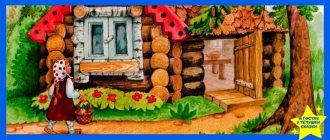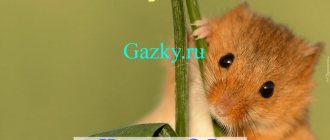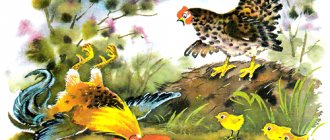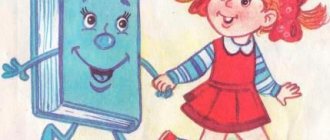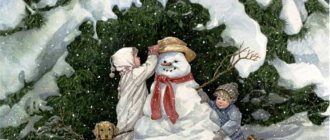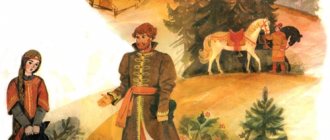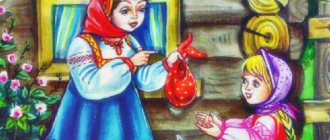The Russian folk tale Kolobok is one of the very first fairy tales in the life of every child. Kolobok was and remains the most famous fairy tale for children. On our website, parents will not only be able to read a fairy tale about Kolobok to their child, but also little listeners can listen to this story via audio, or even watch it on video. Colorful illustrations will make reading the fairy tale even more interesting and exciting.
Read the fairy tale Kolobok with pictures
Once upon a time there lived an old man and an old woman.
So the old man asks: “Bake me, old man, a bun.” - What should I bake it from? There is no flour. - Eh, old woman. Mark the barn, scratch the bottom of the tree, and you'll get it. The old woman did just that: she swept, scraped together two handfuls of flour, kneaded the dough with sour cream, rolled it into a bun, fried it in oil and laid it on the window to dry.
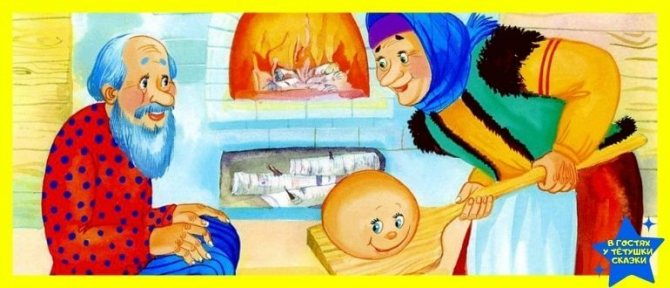
The bun got tired of lying - he rolled from the window to the bench, from the bench to the floor - and to the door, jumping over the threshold, into the entryway, from the entryway to the porch, from the porch to the yard, and then beyond the gate, further and further.
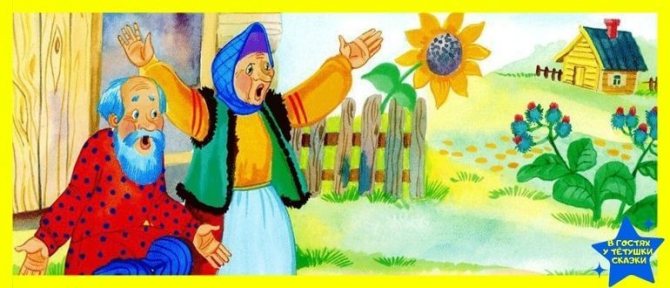
The bun is rolling along the road, and a hare meets it:
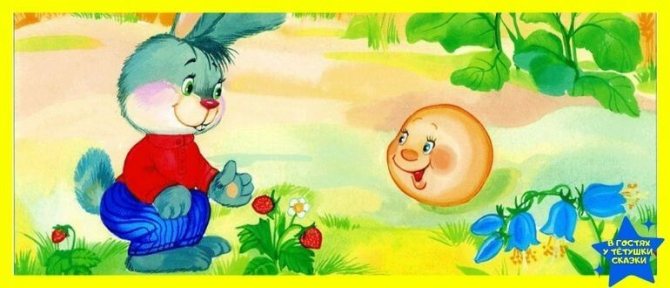
- Kolobok, Kolobok! I will eat you! - No, don’t eat me, scythe, but rather listen to what song I’ll sing for you. The hare raised his ears, and the bun began to sing: “I am a bun, a bun, swept across the barn, scraped along the knots, mixed with sour cream, planted in the oven, chilled at the window.” I left my grandfather, I left my grandmother, It’s not smart to leave you, hare. And the bun rolled on - only the hare saw it. A bun rolls along a path in the forest, and a gray wolf meets him:

- Kolobok, Kolobok! I will eat you! “Don’t eat me, gray wolf: I’ll sing you a song.” And the bun began to sing: “I am a bun, a bun, swept across the barn, scraped along the knots, mixed with sour cream, planted in the oven, chilled at the window.” I left my grandfather, I left my grandmother, I left the hare, It’s not smart to leave you, the wolf. And the bun rolled on - only the wolf saw it. The bun is rolling through the forest, and a bear comes towards it, breaking brushwood, bending bushes to the ground.
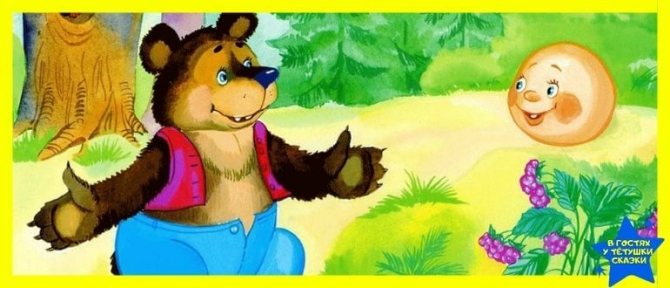
- Kolobok, Kolobok, I will eat you! - Well, where can you, clubfoot, eat me! Better listen to my song. The gingerbread man began to sing, and Misha's ears went wild: “I am a gingerbread man, a gingerbread man, swept across the barn, scraped through the knots, mixed with sour cream, planted in the oven, chilled at the window.” I left my grandfather, I left my grandmother, I left the hare, I left the wolf, It took me half a long time to leave you, bear. And the bun rolled - the bear just looked after it. The bun rolls, and a fox meets it:
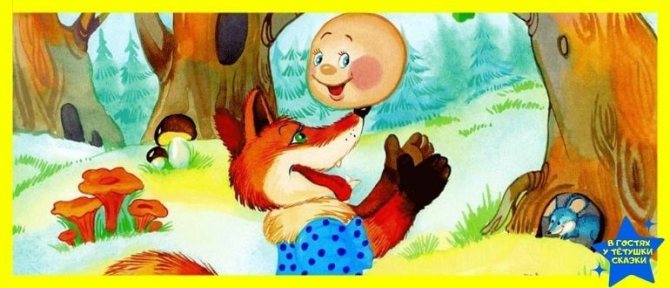
- Hello, bun! How handsome and rosy you are! The gingerbread man is glad that he was praised, and began to sing his song, and the fox listens and creeps closer and closer: “I am a gingerbread man, a gingerbread man, swept across the barn, scraped along the knots, mixed with sour cream, planted in the stove, chilled at the window.” I left my grandfather, I left my grandmother, I left the hare, I left the wolf, I left the bear, It’s not smart to leave you, fox. - Nice song! - said the fox. “The trouble is, my dear, that I’ve become old—I can’t hear well.” Sit on my face and sing it one more time. Kolobok was delighted that his song was praised, jumped on the fox’s face and sang: “I am a Kolobok, a Kolobok... And his fox is a racket!” - and ate it.
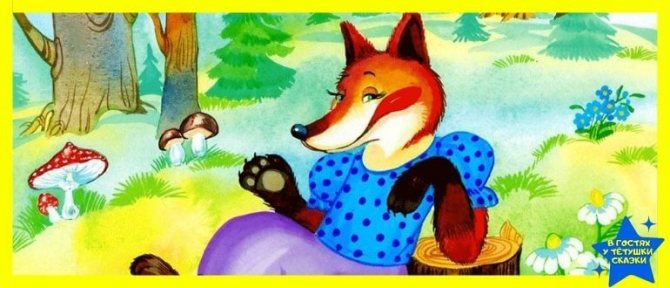
Russian fairy tale
Children's fairy tale "Kolobok" about the eternal wheel of life
A child learns the Russian folk tale “Kolobok” even before he begins to learn to read. Parents use a children's book to tell their child about animals that may be encountered along the way if he suddenly decides to run away from home. The fairy tale is especially memorable when the grandmother reads it with expression at night; the impressions of the adventures of the main characters remain in the child’s memory for many, many years. As children grow up and learn about the changing seasons, the deep meaning of the old fairy tale can be explained to them. In kindergarten or school, teachers will be able to convey to the children what the people who came up with this funny and interesting story wanted to tell. In children's literature of different nations there are fairy tales similar to Kolobok. For example, among the British it is Johnny Donut, among the Irish it is Fat Flatbread, Pancake among the Scandinavians and the Gingerbread Man among the Germans. Why is this character found in books for children from completely different nations and who are the Hare, Wolf, Bear and Fox? To answer this question, let's take a closer look at them: Kolobok is the main character of an old fairy tale. This is unleavened bread baked from flour, butter and milk. The word “kolobok” is found in Greek and means wheat bread. The people who came up with the fascinating story imagined the red sun in the form of a Kolobok. A hot ball rolls across the sky all year round and gives all living things light, warmth and the joy of being. The hare is the first character that Kolobok met. It denotes winter, which begins every year. The wolf is the second character from whom Kolobok ran away. It represents spring, when the snow is melting, but nature is still gray and cold. The bear is the third character who wanted to eat the ruddy Kolobok. This is summer, generous and rich in food supplies. The Fox is the fourth character who managed to deceive and eat Kolobochka. She personifies the red autumn, when it is time to gather rich harvests, put them in barns and then feast on the reserves during the cold winter season. Grandfather and grandmother are the ancestors of all humanity, they love the warm sun very much and do not want it to run away. Kolobok is the hot sun that accompanies the change of seasons. The protagonist's journey means the eternal cycle of nature, and the old man and the old woman will bake Kolobok again and again so that life on Earth never ends.
Story with illustrations for family reading
A fairy tale with meaning will definitely appeal to all readers who look at the page. And photographs of bright nesting dolls, pictures and drawings will add liveliness to children's perception. Through unusual illustrations, children will get acquainted not only with the main characters of the fairy tale, but also learn about skilled craftsmen from the villages of Fedoskino, Mstera and Kholui. Large font text will help you quickly read the fairy tale and expand your vocabulary with the richness of your native Russian language. After reading, it is advisable to consolidate the impression and watch a fascinating hand-drawn cartoon or listen to a beautiful melodic audio fairy tale .
Origin of the word "Kolobok"
Kolobok is a diminutive of the word kolobok. In turn, kolob is a ball of dough rolled up, a small, round-shaped loaf of bread, a dumpling made from unleavened dough. A fluffy, round flatbread, produced in the form of a bread lump, often a ball or itself expanding into this shape at the end of baking. In the dialects of the Tver region there are the words: kolobukha - lump, dumpling; koloban, which means a thick cake, as well as the word okolobet meaning to shrink.
Some scholars believe that the word was borrowed from other languages, for example, it comes from the Greek kollabas, which means “wheat bread” or from the Swedish klabb meaning “chock”, “log”. There are also opinions about the Norwegian origin of the word from the noun klabb, translated meaning “whom”, or from other Scandinavian languages, for example, from kolfr (pole, beam). At times the word kolobok is correlated with the Latvian kalbaks, which means a hunk or crust of bread.
However, these versions of the origin of the word kolobok do not seem convincing due to the huge phonetic differences.
Audio tale Kolobok listen online
The audio tale Kolobok will help your child learn his first life lessons - simple at first glance, but filled with wisdom. So, this story begins with the fact that our ruddy and chubby hero decides to leave home and see the world. And then he will meet with different characters who strive to feast on him, because he is made of dough.
Although the ending is not as optimistic as other fairy tales for children, listening to Kolobok is not at all scary and is very useful. In accessible language, the child is explained that there is no need to run away from adults and trust strangers.
Russian folk tale Kolobok:
I definitely agree with the expression that the bun fairy tale will help you learn your first life lessons. But not all children will like the audio fairy tale format, since most want to listen to it live from their parents.
I used to love fairy tales as a child and often read them, the fairy tale about Kolobok is one of my favorite fairy tales, now I decided to refresh my memory and listen to an audio book.
I used to love fairy tales and often read them as a child; the tale about the Kolobok is one of my favorite fairy tales.
Kolobok is the best fairy tale; in my opinion, children should read it first; it is very easy to read and simple to understand; children really like it. And the meaning is also not without its usefulness to listen to. There are even three options and all three are good.
Probably parents read fairy tales to all their children. I remember the voice of my mother and grandmother who always read at night...Now audio recordings are coming to the aid of parents...but nothing can replace their native voice
Nice tale. Children begin to introduce it to it from early childhood. At one time, when I had to do housework, I gave the child a fairy tale in pictures and played audio. I observed and saw that the child liked it and was busy “reading” in his own way. So, undoubtedly, audio fairy tales are an excellent assistant for parents.
An excellent option for a baby monitor. Even 2 time options are applicable to different circumstances. The tale is interesting, calm and not very annoying. You can put it on play and go about your business. There is no need to worry about the child’s psyche.
An excellent option for a baby monitor. Even 2 options, due to various circumstances, there is a choice. The tale is interesting, calm and not tense, you can play it and go about your business. There is no need to worry about the child’s psyche.
An excellent option for a baby monitor. Even 2 options, due to various circumstances, there is a choice. The tale is interesting, calm and not tense, you can play it and go about your business. There is no need to worry about the child’s psyche.
As a child, I never perceived this fairy tale in the sense that you should not talk to strangers. Perhaps because she did not live in a big city at that time and there was essentially no one to fear. Everyone is either neighbors or neighbors of neighbors. Now, of course, the situation is different. You worry about the children, instill safety rules, and listen to the fairy tale about Kolobok with the kids.
I remember this fairy tale very well from my kindergarten days. And quite a lot of cartoons have been made based on it. I’ll definitely listen to it in audio format as soon as I have some free time. Still, this is a classic in its own way.
Source
We recommend you listen
Winnie the Pooh and the Honey Tree - Disney audio fairy tale
Listen to the fairy tale “Winnie the Pooh and the Honey Tree” from Walt Disney Studios online on the Mishkina Books website!
Masha and the Bear - Russian folk audio fairy tale
Listen online to the Russian folk tale “Masha and the Bear” on the Mishkina Books website!
Where does a hedgehog get its needles - an audio tale by Elena Potapova
And the TONGUE, I ate it
